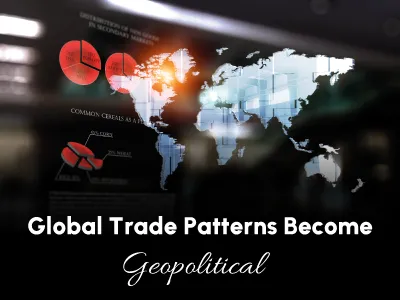
Global trade is expected to contract by around 5% in 2023 due to geopolitical tensions and changing trade patterns. According to UNCTAD's latest Global Trade Update, global trade is projected to shrink by about $1.5 trillion, down 5% from its record high in 2022, to less than $31 trillion.
UNCTAD's Global Trade Update, published on December 11, continues to paint a "highly uncertain and generally pessimistic" outlook for 2024, citing factors such as geopolitical tensions, rising debt, and widespread economic fragility in the ongoing period. However, other factors negatively affecting this situation include declining demand in developed countries, increased trade restrictive measures, reduced trade in East Asia, fluctuations in commodity prices and extended supply chains, especially between China and the United States.
A $500 billion increase in trade in services and a slight increase in trade volumes indicate resilient global import demand. The sector grew by 7% in 2023, partly thanks to the delayed COVID-19 recovery. Moreover, some emerging economies, notably Mexico and East Asian countries, have had opportunities to integrate better supply chains affected by geopolitical concerns.
Frend-Shoring is a growing trend
The report shows that global trade patterns are increasingly influenced by geopolitics, with countries favoring politically aligned trading partners - a trend referred to as "friendship union."
This trend has become more pronounced since late 2022. Meanwhile, geographic proximity in international trade - near or far storage - has remained relatively stable.
The report also highlights a marked increase in trade concentration. "There has been an overall reduction in the diversity of trading partners, suggesting that global trade is concentrated within major trading relationships."
Trade restrictive measures on the rise
The Global Trade Update notes a significant increase in trade-restrictive measures, particularly non- tariff measures (NTMs), in 2023.
According to the report, this increase is driven by a resurgence of industrial policies and the need for countries to fulfill their climate commitments. These factors have led governments to favor policies that support domestic industries and reduce dependence on foreign supply chains. Another recent UNCTAD report, Trade Arrangements for Climate Action, identified 2,366 NTMs related to climate change, affecting 3.5% of all potential tradable goods and covering 26.4% of global trade. In this context, the Global Trade Update report says: "These inward-looking policies are expected to hinder the growth of international trade."
A mixed picture for main sectors
UNCTAD's latest update on global trade paints a mixed picture across economic sectors. The report shows a decline in 2023 for office and communication equipment (-17 %), textiles (-13%), and apparel (-11%), while sectors such as road vehicles and transportation equipment show growth rates of 13% and 25%, respectively. However, the positive annual trend in these sectors started to decline in the third quarter of 2023.
Looking ahead to 2024, the commodity sector faces continued uncertainties due to ongoing regional conflicts and geopolitical tensions. Therefore, the growing need to secure critical minerals vital for the energy transition is expected to increase volatility in these markets.
 Back
Back







